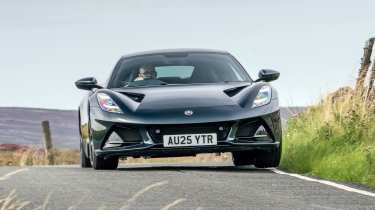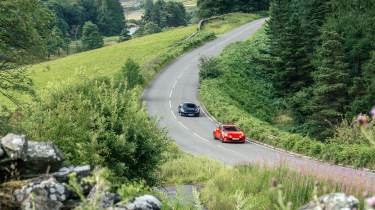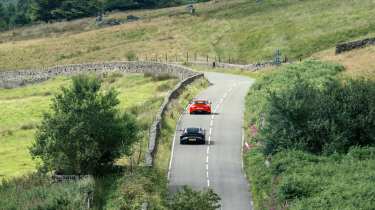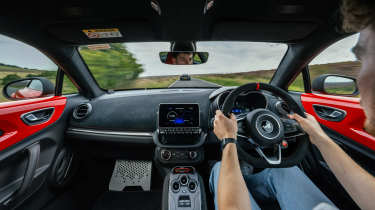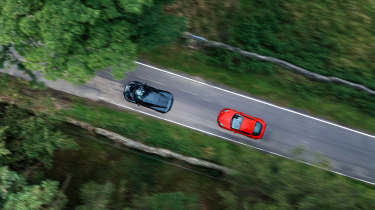Lotus Emira Turbo SE v Alpine A110 GTS – two of the last surviving mid-engined sports cars
The Lotus Emira and Alpine A110 are sports car heroes with uncertain futures. Which should you enjoy while you can?
A pair of thrilling, lightweight sports cars on a scenic, undulating road. What should be a party is in danger of becoming a wake. Lord knows what the latest news from Hethel will be by the time you read this, but Lotus’s denial of the plant’s rumoured closure felt a touch thinner when it announced 550 redundancies at the home of Emira production. We already know that Alpine will soon lay the A110 to rest in its current form: we’re in the final year of production as things stand, with an electric replacement to come. The same goes for our duo’s Porsche 718 rival, for which the order books recently closed – albeit quickly followed by Porsche confirming ICE will still be offered in the next-gen car.
So let’s smile about what we do still have. The Lotus is freshened up in new Turbo SE spec, which uprates the base, AMG-powered four-cylinder Emira to 400bhp while ticking plenty of the most desirable and dynamic options boxes. The Alpine is, um, old. A rejig for the final year of production has since morphed this A110 S into a GTS, but we already know the various permutations of this little coupe well enough to be delighted with whatever we’re given. More than.
While their two-seat, mid-engine, rear-drive schtick is similar, there’s a minor gulf between these two on paper. The Alpine is the underdog, priced from £69,890 in new GTS form, its Renault-sourced 1.8-litre turbo four producing 296bhp at 6300rpm and 251lb ft from 2400rpm. With just 1102kg to shift, it’s quick, the Dieppe folk claiming 4.2sec to 62mph and a 170mph top speed with the optional aero kit. As with this S, the GTS adds lower, stiffer ‘Cup’ suspension. If you don’t want it, you buy the base £55,160, 249bhp A110.
More reviews
Group tests
In-depth reviews
Reviews
The Lotus appears to operate in an echelon above, straddling the line between sports and supercar not only with its more eye-grabbing design but also its £89,500 price tag and healthier engine outputs. These sit closer to the AMGs it shares its engine with, though it still gets its own unique set-up: the Turbo SE’s nice, round 400bhp arrives at 6800rpm while its 354lb ft peak torque hits at 3000rpm. It’s notably heavier than the A110 though, at 1455kg, ensuring its performance is only sharper to a degree; the claims are 4.0sec and 181mph, making it a mite quicker than the Emira V6. It will need to be more polished than the V6 too, as that car came up short against the entry-level A110 in our recent five-contender sports car showdown (evo 336).
Back when evo was launched in 1998, Lotus made two cars – the Elise and Esprit. A succinct range and an indisputably desirable one. Today things are murkier, the Emira having broadly hit the spot for us without truly sticking its landing, and the all-electric Emeya and Eletre being vast in both size and the amount of emotional baggage they carry. They might soon deploy hybrid power, as could the Emira, the twists and turns of tariffs and falling EV demand (and therefore used values) tearing down plenty of car makers’ transition plans. Lotus’s Geely cousins at Polestar are sticking steadfastly to plug‑in performance but have delayed their 6 Roadster for a little while longer.
Maybe we all need a dose of nostalgia to cling on to like a comfort blanket, and thus the Turbo SE badge, previously affixed to one of the best-selling Esprits, makes a comeback. Punchy four-cylinder power in a dramatically portioned coupe also mirrors the old wedge’s recipe quite nicely. As do its blink-and-you’ll-miss‑’em exterior tweaks.
‘It would’ve been nice to see some visual updates in line with the new power,’ says Sam Jenkins at our Peak District muster point, evo’s senior staff writer echoing my own thoughts about the meagre Turbo SE badge affixed behind the rear quarterlight on either side of the car. We’re both quick to acknowledge just how knockout this car still looks three years on, mind. If your mates all have Caymans, it’s very easy to see why you’d be tempted to veer off in the Lotus’s direction. And it’d be just as easy to convince non-petrolheads that it’s worth several times its asking price, which goes some way to offsetting our disappointment that the Emira never lived up to its ‘sub-£60k’ launch promise.
While the power uplift makes the SE the swiftest Emira, it’s not much lighter than the V6 owing to its standard seven-speed twin-clutch gearbox weighing more than a six-speed manual. It’s no mere powertrain transplant either, the 2-litre turbo engine entailing its own subframe, wishbones, uprights and track wheel offsets alongside a new exhaust.
‘It’s going to be driven by people who are new to sports cars,’ Lotus chassis guru Gavan Kershaw tells me. ‘So they want to lean on the electronics a little bit more for even more agility. People probably aren’t going to turn the systems off and drift it.’ With the performance and pricing of a Turbo SE and V6 so relatively close, he reckons many people will be choosing this car because they want the DCT ’box. ‘When we had a manual gearbox, people always asked for a paddleshift. When you give them the paddleshift, they say, “Wouldn’t it be nice to have a manual?”
‘Some of the biggest decisions we’ve made for the SE concern its gearbox character and shift points. People want it to be economical and efficient and not constantly holding gears in Tour mode. But outside of that, how sporty do you make it? Ultimately if you’re on a B-road, you’re probably going to take over with the paddles.’
One criticism of the original Emira i4 concerned its occasionally aloof transmission, but Kershaw’s team have teased some very welcome focus out of it for this Turbo SE, which seems to act as a bit of a covert facelift for a car that received a slightly mixed response at launch. In my brisk but unhurried run to meet Sam and photographer Aston Parrott, it generally ticked along in fifth or sixth gear on flowing A-roads, a slight tweak of throttle quickly dropping it to a lower gear when opportunity arose. No need for Sport or Track mode, nor a flex of its paddles. Which aren’t as satisfyingly damped or neatly placed as they could be – a missed opportunity when the twin-clutcher sits high among the four-cylinder Emira’s selling points. ‘It’s fine for something like an A45 but not quite up to standard for a circa-£100k sports car,’ Sam astutely notes.
Still, the mapping is decent in auto and having both hands on the wheel is useful when it comes to stoking up this car’s more engaging side. At modest speeds it’s not as easy to rub along with as its glorious forebears, the oddly shaped rim of the wheel initially convincing you to take a couple of bites at corners while you figure out its response, and the damping rather too tough for the worst of British road surfacing. Kickback through the wheel borders on alarming in your first few miles and although you learn to trust that it’s merely a vivid stream of communication – conscious correction is rarely, if ever, needed – it unnerves you in a way the Alpine simply doesn’t.
Upping the pace finally sparks the car fully into life. With more force through the dampers, its communication clarifies, the steering weight is more natural and the whole thing feels alert, precise and trustworthy. While heavier than we’ve known Lotus sports cars to be, it’s still light enough to allow later braking than you might typically employ, too.
It’s never an especially dramatic or expressive car, living up to Kershaw’s promise to coddle sports car newbies. There’s little immediate change in its behaviour as you loosen the electronics, betraying either strong innate balance, the light touch of its nannies or, most likely, an impressive mix of the two. You’d need the speed and space of a racetrack to really cut shapes in it, I suspect, but the rapid flow you learn to achieve feels mighty enough on road. Even if the M139 engine doesn’t have the bass or bombast of its German applications. You instead source entertainment from the chuffs and whistles of its forced induction, the engine perched right behind your ears. Shame it’s hidden entirely behind a plastic cover – too many AMG badges, perhaps…
‘It feels really boosty, and if you open the left-hand window it fills the cabin with turbo and wastegate sound,’ smiles young gun Sam, ‘which is nice.’ My more mature observation is that it’ll easily achieve 40mpg on a long run and the copious space behind its seats (unlike an Evora, it’s a pure 2+0) can swallow enough luggage for a decent getaway, a point proven by my partner and I on a trip to Edinburgh a few days after this shoot. He grew up a stone’s throw from Hethel and swelled with pride at the sheer competence on display. This is an all-rounder like Lotus has rarely made before, though it may prove sage to choose its softer, no-cost-option Touring suspension if that’s your intended use case.
The A110 won’t ever feel as flexible. Its boot is smaller and interior space just a bit more cramped – I doff my cap to anyone who runs a wee Alpine as a one-car garage. But its more singular focus results in a much slimmer figure, its 350kg advantage over the Emira obvious from the off. You need to interrogate both cars’ launch control systems back-to-back to really feel the extra muscle of the Lotus, which mostly comes on song beyond 60mph anyway.
It may have been on sale nearly eight years, but hopping into the French lightweight remains a breath of fresh air. It’s fizzy and effervescent enough to make the Lotus seem overwrought and a bit studious. Even its engine feels a star component in a way the Emira’s doesn’t, despite humbler origins. It’s more vocal at idle and low revs, parping and snarling away whichever of its modes you’re in. The orchestrated pops and bangs in Sport and Track cheapen the experience – to quote my esteemed colleagues from our recent Eras series – though they stop short of truly offending.
Indeed the stock A110 has been in evo a lot lately, covering itself in glory in the aforementioned group test and also winning the hearts of judges in our 2010s Eras test – the decade most enjoyed by the judges, in fact, making the little Alpine one of the brightest stars of our vast, five-issue endeavour to map out the last 50 years of performance car history. That’s pretty astonishing for a Renault-engined curio, but then it is quite an astonishing car.
In GTS trim it exudes a different character, though, the unique, softly sprung spirit that we adore in the base model blunted by a bit of convention. Compared with the stock A110 it’s 4mm lower with 50 per cent stiffer springs and 100 per cent firmer anti-roll bars, its greater tenacity aligning it much closer to a Cayman. Perhaps the aim is to win over Porsche customers wary of change, in which context it takes on greater significance in the range.
‘Agility’ was still clearly the largest word etched on its mood board, however. This is a sparky car even in its default driving mode and it’s some time before you feel the need to tease anything more from it – it’s fresh right out of the box. It’s not the same supple and amiable car as a base A110 and it can feel as belligerent as the Sport-suspended Lotus over these same roads. It’s friendlier, however, pottering through towns and villages just like a Mégane RS. Whether that constitutes criticism in a £70k semi-exotic is probably up to its buyers, but to me it’s a deliciously simple car to just get in and start operating – there’s zero pretence to its ‘Taste the Difference’ translation of Group Renault switchgear and layouts. Very few of its controls feel tangibly Clio or Scenic, which is a really neat trick to have pulled off. The supercar-lite gear selection buttons (which also save the new A290 hot hatch from the fiddly selection stalk of its inner Renault 5) crank up the exoticism further, while weight and cost-saving measures such as the exposed metal doors bring colour and excitement inside. Choose a vibrant hue like this Seismic Red to really amplify the feeling.
Perhaps its neatest ergonomic trick concerns its fixed metal paddles, which protrude upwards and catch your flick-flacking fingers far better than the Emira’s. Indeed this is a lovely gearbox to operate all round, and when you need to overtake some slow-moving agricultural machinery – or keep up with Parrott in his ridiculous new Skoda Superb Sleeper long-termer – just the tiniest twitch of throttle can kick you down the correct amount of gears, right into a swell of torque that the 1100kg Alpine surfs so easily upon. It’s also fun to play tunes with its turbo four to liven up more laborious stretches of road, a stolen act of amusement the Emira never really encourages. While we’re hardwired to crave the hypothetical manual version of cars like these, the A110 feels honed and wholly natural with this DCT.
This is a car to really imprint your own driving style upon, arguably more so than a base A110. The steering feels lovely, eager in your hands and pointing the Alpine’s nose into corners like it’s a hot hatch. You sense the magic cast by Renault Sport engineers and you can be aggressive with this car in a way you’re reticent to be in the more enigmatic Emira. You just go harder, faster and play around with its balance more, the rapscallion DNA of various RS Clios and Méganes bubbling right at the surface.
Spending time in the GTS does serve to highlight how much of a joyful and inimitable proposition the base A110 is on its suppler suspension. Here, you occasionally wince when a really nasty surface comes into view. Yet I remember loving this car on its press launch, having a ball around Estoril and coming away thinking it helped pitch Alpine against its established rivals a bit more convincingly. We don’t begrudge the variety of initialisms Porsche lobs after the Cayman and Boxster badges, after all.
‘It might be tightened up over the standard car but the A110 feels really compliant on these roads – calm and composed and ludicrously agile,’ observes Sam. ‘It really does feel its lower weight and you don’t feel as if you’re having to fight physics to hustle it along. It feels just as quick as the Lotus to me, with the sharp, tactile shifts and gruffer, more immersive engine note helping matters.’
The snazzier styling and more sumptuous cabin of the Emira do make themselves felt in this company, and its lungs are undeniably the larger of this pair as your speeds rise. It has star quality, yet once again an A110 has delivered superstar sensations. Its impending replacement may be sketched out as electric – gaining weight and surely sacrificing delicacy in the process – but the Alpine suits talk openly of other power sources, their sexy Alpenglow concept even dabbling with hydrogen. The immediate future of these cars may feel in flux, but let’s relish them while we can – and buckle up and embrace whatever fascinating new chapter comes next.



